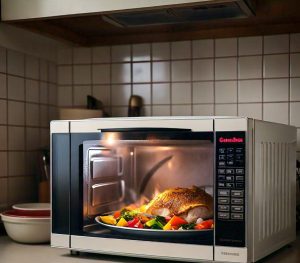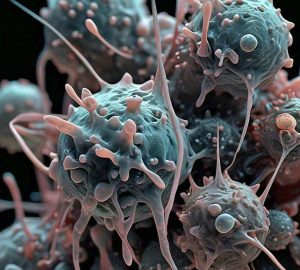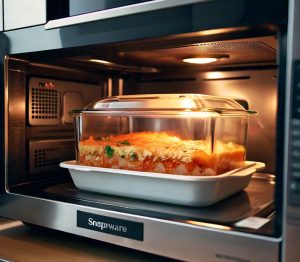Bacteria are single-celled organisms that can be beneficial or harmful, reproducing rapidly in ideal conditions.
The question to be addressed is whether microwaving can kill them.
This article provides comprehensive details about bacteria and their response to microwaving. It discusses if a microwave can kill bacteria, how long they should be exposed to the heat for effective sterilization, and whether this process affects the nutritional value of food items. In scenarios where microwaving doesn’t work as an effective method, we will suggest alternatives for eliminating bacteria. Furthermore, the discussion includes precautions one must undertake while attempting bacterial extermination through a microwave along with some frequently asked questions related to this topic. Keep reading till the end for our final words on this matter!

Jump To:
Does a Microwave Kill Bacteria?
Yes, microwaving can indeed kill bacteria. However, it is not the microwave radiation itself that destroys bacteria but the heat generated by the appliance. Different types of bacteria require varying degrees of heat to be killed off; some might perish at relatively low temperatures while others may survive until much higher temperatures are reached. Microwaving food to an appropriate temperature, typically above 165°F (74°C), can knock out a host of potentially harmful microorganisms like Salmonella and E.coli.
Check out if ants can survive a microwave.
Facts About Microwaving and Bacteria
Here, we will discuss the important things to note about microwaving and its effect on bacteria.
- Type of bacteria: Not all bacteria are killed by microwaves. Some types may withstand microwave radiation or can survive in heated environments.
- Temperature: Microwave heating must reach a certain temperature range (usually above 60°C) to effectively kill most bacterial species. However, these temperatures might not be reached in every part of the food due to uneven heat distribution.
- Cooking Time: The duration of cooking can influence how much bacteria is killed. Longer cooking times at appropriate temperatures typically result in more extensive bacterial kill-off.
- Type of Food: The type of food being microwaved also plays a role since some foods heat more evenly than others, affecting the overall reduction in bacterial numbers.
In conclusion, while microwaving has potential bactericidal effects under suitable temperatures and conditions, it does not guarantee complete elimination of all bacteria present.
Now we will discuss other considerations when using a microwave for sterilization purposes or reheating foods.
How Long Can You Microwave the Bacteria to Kill Them?
The duration of microwaving needed to kill bacteria varies depending on several factors such as the wattage of your microwave and the type of bacteria. On average, it can take between 1-5 minutes at high power for most common household microwaves. However, understand that not all types of bacteria are destroyed by heat or radiation from a microwave. It’s always essential to ensure your food is heated thoroughly, ideally reaching an internal temperature of at least 75 degrees Celsius.
Check out if cockroaches can survive a microwave.
Does Heating Bacteria in a Microwave Damage It?
Absolutely, exposing bacteria to high temperatures in a domestic setting like using a microwave often damages or kills them. The intense heat generated within the appliance destroys their cellular structure leading to their eradication. Though this method is effective for many types of harmful pathogens, some thermally resistant strains might survive even after being subjected to such temperatures.
Does Heating Food with Bacteria Affect its Nutritional Content?
Heating food that contains bacteria in a microwave does little harm to its nutritive value while ensuring safety by killing potentially harmful microbes. Microwaving utilizes short cooking times which help maintain nutrient retention. Nevertheless, overcooking any food item could lead to nutrient loss regardless of whether they contain unwanted microorganisms or not.
Check out if mice can get into the microwaves.
Does Heating Food that Contains Bacterial Contaminants Affect its Flavors?
Microwaving food contaminated with certain types of spoilage organisms like pseudomonas may result in off-flavors due to their metabolic activities during the growth phase prior to cooking but generally speaking, reheating itself doesn’t typically alter taste properties unless it’s overdone leading to undesirable texture changes perhaps affecting overall sensory perception indirectly.
In conclusion, we have discussed how long you need to nuke various forms of bacterium inside our household microwave, its effect on the microorganism and any potential change to food quality during this process.
Next, we will be delving into frequently asked questions surrounding this topic.

Frequently Asked Questions (FAQs)
We will now look at the most commonly asked questions related to microwaving and heating.
Can microwaves kill bacteria?
Yes, microwaving can kill bacteria. The heat generated by the microwave’s high-frequency radio waves effectively kills many types of bacteria when food is heated to a safe temperature. However, it’s crucial that all parts of the food reach this temperature for effective sterilization. As such, rotating or stirring food during cooking ensures even distribution of heat.
Can microwaving affect the nutritional value of food?
The process of microwaving does not inherently affect the nutritional value of foods any more than other cooking methods. In fact, because some nutrients are sensitive to both heat and time exposure, shortening cook times through microwave use may actually preserve more nutrients compared to prolonged conventional cooking methods.
Are all materials safe to microwave?
No, not all materials are safe for microwave use. Metal containers or foils can cause sparks leading to fire hazards in microwaves due to the reflection of radiation back into itself causing overheating. Plastic containers marked as ‘microwave-safe’ should be used in order to avoid harmful chemicals leaching into your food upon heating.
Does microwaving alter the taste of food?
Microwaves themselves do not alter taste directly; however, they might indirectly do so by affecting texture or moisture content if improperly used. By using suitable containers and appropriate power settings you can maintain good taste and texture in your heated meals.
This concludes our FAQs section on microwaves and heating techniques with respect to their effects on microbes and nutrition along with safety measures for material selection inside a microwave oven unit.
Final Word
In conclusion, microwaves are a powerful tool for heating and cooking food swiftly and conveniently. They can kill bacteria if used properly, and they won’t excessively damage the nutritional value of your meals if timed correctly, but caution must be taken to use microwave-safe containers to ensure safety and taste satisfaction. Understanding these factors would allow you to make effective use of this common kitchen appliance.



